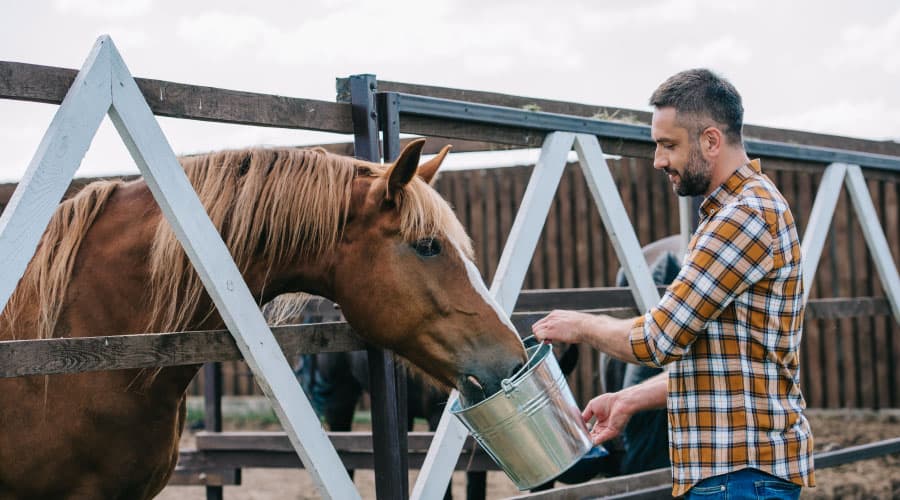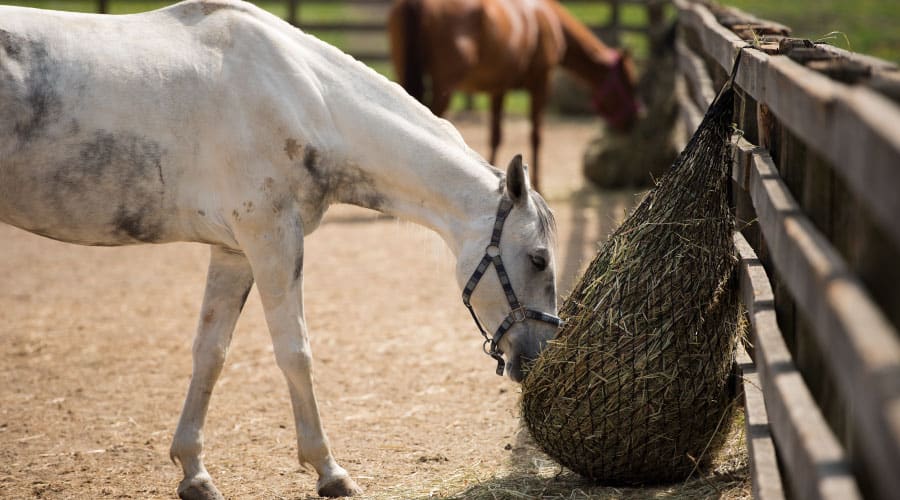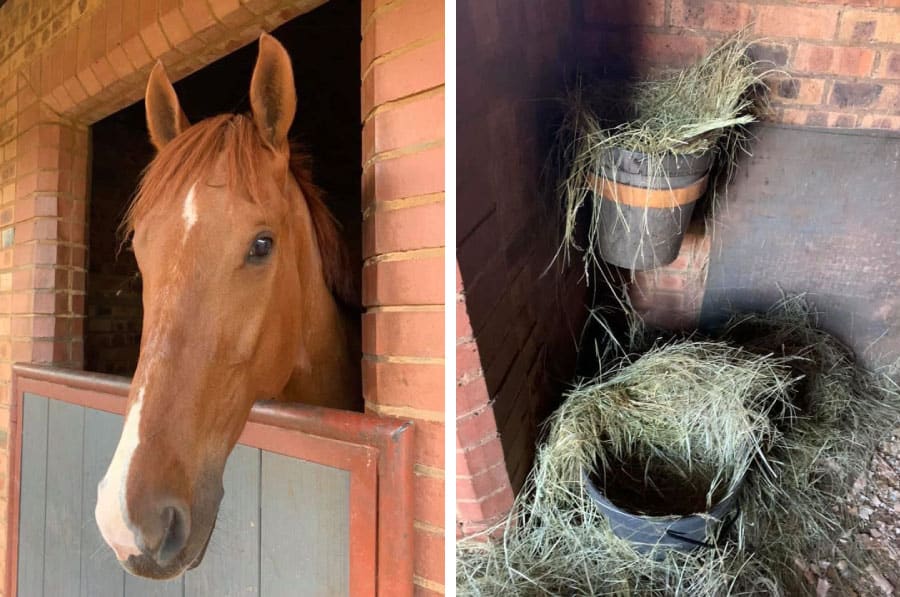- Your source for stall mats, rubber arena footing, arena harrows and arena dust control.

As a young rider, I used to get up at the crack of dawn to feed my horse before my ride. My trainer at the time used to say, “Remember to wet the food”, and I always used to wonder why. So why should you wet or soak your horse’s feed? What are the benefits? Is there any harm in wetting or soaking feed? Is it better to soak or steam your horse’s hay?
before my ride. My trainer at the time used to say, “Remember to wet the food”, and I always used to wonder why. So why should you wet or soak your horse’s feed? What are the benefits? Is there any harm in wetting or soaking feed? Is it better to soak or steam your horse’s hay?
Wetting a horse’s food will aid in hydration and digestion. Hard food such as pellets and cubes will soften and reduce the chance of chocking and food becomes easier to chew for older horses with dental issues. Soaking hay reduces the dust particles alleviating allergies and sensitivities. Soaking hay is an effective way of removing nonstructural carbohydrates and will also aid in better hydration.
It is important to understand the pros and cons of wetting your horse’s food and soaking your horse’s hay.
Wetting Food or Grain
There are many benefits to wetting your horse’s food and it can’t cause harm to wet the food either. Let us look at some of the benefits of wetting your horse’s food.
Hydration
Hydration can occur especially during winter or even summer months when horses do not drink enough water. This can cause poor digestion, causing your horse’s food to not pass through the gut normally which can lead to things like impaction colic. Soaking and wetting the horse’s food will ensure adequate water intake with every meal.
Choking
Some hard feeds such as pellets and cubes will require the food to be soaked to soften the feed and reduce the chance of chocking. Soaked food will ensure your horse does not choke on hard pellets and softer mushy feed will avoid something getting stuck in your horse’s throat. Wetting food should be done especially if this has happened before and your horse is prone to choking.
Product requirements
For some feed such as beets, like Speedy beets, the product will specifically indicate that the feed must be soaked for a certain duration to absorb an excessive amount of water before feeding it to your horse. This is important and should not be ignored as you do not want a large mass of the feed blowing up inside your horse’s stomach and risking colic. Soaking products such as speedy beets can take up to 40 minutes to soak before feeding your horse.
Supplements
Your horse might require additional supplements to be added into his feed. It’s important to mix the supplements well into the feed as most supplements do not taste nice for horses. After your horse has grabbed a big mouthful of bad-tasting Calcium, for example, he might be put off by the food. Adding water to the feed can make it easier to mix in the supplements into the horse’s feed properly before feeding it to your horse and thereby masking the bad taste of the supplements.
To summarize:
- Ensures adequate water intake with every meal for better hydration, especially in winter when horses tend to drink less water.
- Reduces the chance of your horse choking (hard pellets, beets, or cubes).
- Easier to eat for older horses with dental problems.
- Easier to mix in supplement with your horse’s food.
How much water should you add to food?
The amount of water to add to your horse’s feed will depend on the type of food you are feeding. If you are feeding hard feed such as pellets, then you need to fill the bucket, so the pellets are nearly submerged in water. The pellets will take several minutes to absorb the water and turn mushy.
If you feed your horse soft feed then less water is required, just enough to wet the food. Horses should not be drinking their food, so you want the food to be soggy but not “soupy”.
Remember it is also important to feed small, frequent meals throughout the day to help with digestion. Feeding three or four smaller meals throughout the day is better than one large meal. Horse owners sometimes feed two large meals a day for convenience or due to time constraints, however, it is more natural for a horse to eat smaller meals, more frequently than gulping down a big meal.
If you, unfortunately, can only feed your horse larger meals twice a day, then wetting the food is highly recommended to aid in digestion.
Why soak or steam hay?

Horses can process large quantities of forage to meet their daily nutritional demands. Higher quality hay contains more calories and nutrients. Horses need to chew on forage constantly throughout the day (14-17 hours) and should eat one to two percent of their body weight in roughage every day to maintain a healthy digestive tract, and avoid getting things like colic and ulcers.
Reducing nonstructural carbohydrates
Horse owners soak hay as a viable way in reducing nonstructural carbohydrates (sugar and starches) prior to feeding. Horses with sugar sensitivities such as insulin resistance and horses that are overweight can benefit from soaked hay.
The downside, however, is that while you are soaking hay to reduce the nonstructural carbohydrates in the feed, other essential nutrients may also be lost in the process. Soaking for long periods can leach out other essential nutrients such as Crude protein, calcium, phosphorus, and magnesium concentrations that will all reduce with soaking and your horse’s nutrient requirements might not be met. For this reason, steaming hay might be a better option (see below).
Hydration
Soaking hay increases your horse’s water intake and will help keep your horse hydrated. That is why soaking hay can be an effective way to manage horses prone to impaction colic as it helps keep the horse hydrated. When hay has been soaked or steamed it becomes softer to chew on and digests easier, especially for older horses.
Respiratory health and allergies
For horses that have respiratory issues, soaking hay will reduce the number of dust particles that worsen respiratory problems. Horses that have allergies and are sensitive to the natural dust and particles in hay can benefit significantly from wetting or soaking hay. Soaking will also decrease the amount of mold that is present in the hay.
Cons for soaking hay
Soaked hay can spoil quickly especially during the summer months so it is important to feed soaked hay immediately after soaking. Soaking hay will also significantly increase the bacteria in the hay. Make sure you feed your horse more frequently with smaller portions of the soaked hay and make sure you use clean water every time.
How to soak hay?
The best method is to soak hay is to use a hay net and submerge it in a large water bucket filled with clean water. Soaking the hay for about 30 minutes in hot or cold water prior to feeding should do the trick for most types of hay.
Another method is to have a clever horse like mine who likes to soak his own food in his water bucket as seen in the photo below.

Soaking vs steaming
Steaming hay is not as effective as soaking hay for the removal of nonstructural carbohydrates. However, steaming hay removes far less of the other nutrients when compared with long periods of soaking, and is better to use for active and in-work horses that need all the energy they can get from their food.
As mentioned, soaking increases bacteria and can impact the hygiene quality of the hay. Steaming hay is far more hygienic as it kills bacteria by up to 99%.
Soaking hay can be done at no cost while hay steamers are expensive. It takes more or less the same time to soak hay as it does to steam it. Yet, you will have to allow the steamed hay to cool down before feeding it to your horse.
Conclusion
So whether you soak or steam your horse’s feed, there are plenty of reasons why it is beneficial to do so and many circumstances where it would be considered necessary for the wellbeing of your horse.

